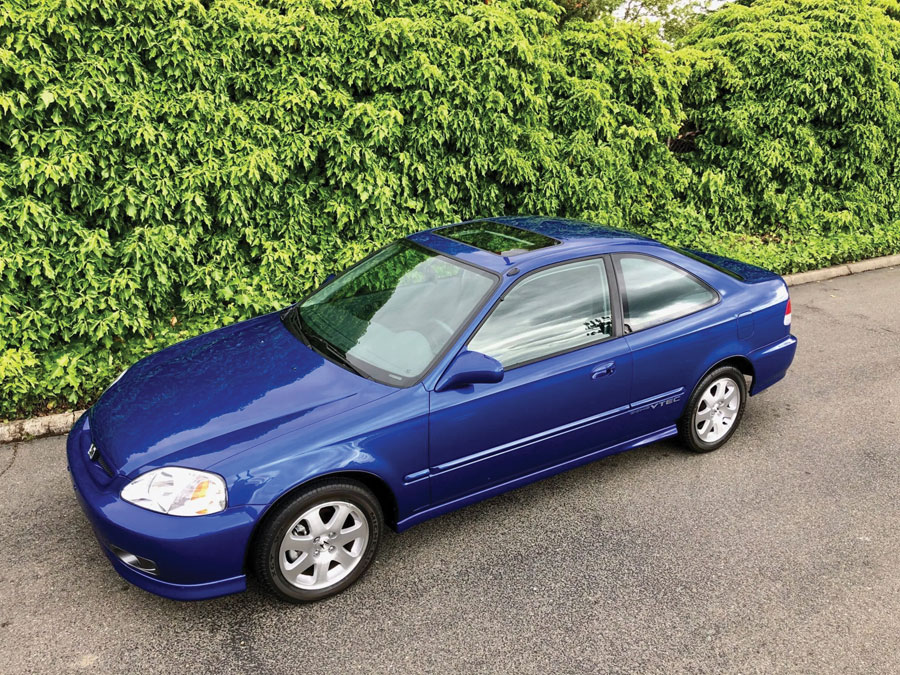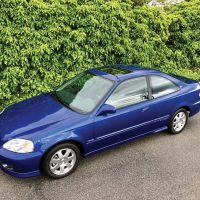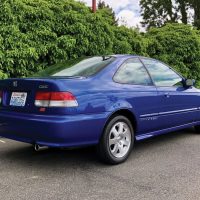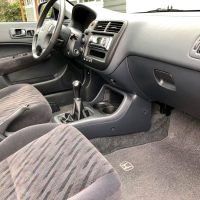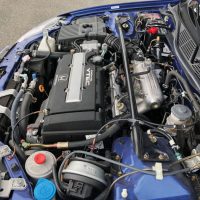- 5,600 miles shown
- 1.6-L B16A2 inline 4-cylinder engine
- 5-speed manual transaxle
- Electron Blue over patterned gray cloth
- Air conditioning
- Sunroof
- Cruise control
- Pioneer stereo
- Window sticker
- Partial service records
SCM Analysis
Detailing
| Vehicle: | 2000 Honda Civic Si |
| Years Produced: | 1999–2000 (this trim) |
| Number Produced: | 33,789 (this trim) |
| Original List Price: | $17,500 |
| SCM Valuation: | $27,000 |
| Tune Up Cost: | $100 |
| Distributor Caps: | $40 |
| Chassis Number Location: | Stamped on top middle of the firewall |
| Engine Number Location: | Front engine, below head, next to transmission |
| Club Info: | Honda-Tech |
| Website: | https://honda-tech.com |
| Alternatives: | 1994–2001 Acura Integra GS-R, 1997–2001 Honda Prelude, 1998–2001 Subaru Impreza 2.5RS |
| Investment Grade: | C |
This car, Lot 32346, sold for $52,500, including buyer’s premium, on Bring a Trailer’s website on June 5, 2020.
For some people, this sale is hell freezing over. For others, like me, it was expected for some time. It’s been a little bit over a year since I told SCMers to watch out for Honda Civics — in our “Buy/Sell/Hold” column (July 2019, p. 88). I also recommended to go for the higher-trim models.
It was also around this time when I received readers’ notes about how these cars would never be collectible.
So, how is this seemingly average car a collectible?
The right time and the right place
Honda first entered the American automotive market in 1969 by bringing their N600 to Hawaii and then later California. The under-40-horsepower car wasn’t very powerful, but had high drivability and very good gas mileage.
Honda then introduced their new model in 1972 — the Civic.
The Civic came at a great point in time as the oil crisis of 1973 had people looking for more fuel-efficient cars to drive. The reliability of this car also won people over very quickly.
Honda’s product-generation cycles were shorter than most other makes at the time: Honda switched the platform up every four years instead of the industry standard of six years.
Honda released the second-generation and then third-generation Civics in 1979 and 1983.
Then came the golden era of Honda Civics — the fourth, fifth and sixth generations from 1988 to 2000.
By the early 1990s, the Civic was known as a cheap, reliable and gas-sipping car. Enthusiasts also realized that this light econobox was also nimble and sporty to drive, thanks to the double-wishbone suspension.
The CRX and hatchbacks were seen in competitive racing, such as the Japanese Touring Car Championship race series in Japan. When the Civic became a racing platform, aftermarket companies started churning out special parts for the cars.
Mods galore
Once the late 1990s arrived, the Civic was one of the mainstay cars in the Japanese custom-car scene. People from all types of car hobbies used Civics as their base platform. Civics were transformed into autocross cone killers, subwoofer-booming trunk rattlers, 10-second front-wheel-drive drag cars — and sometimes even a hydraulic-equipped lowrider.
The little car could do it all. The Civic was a blank automotive canvas waiting for geared artists.
After passing through the early 2000s era of “Fast & Furious” body kits, and the more recent era of “stanced” (cars lowered with very minimal clearance, with the lip of the wheel near the edge of the fender) generation, most of the original cars have been heavily modified.
Even the unmodified ones are approaching 250,000 miles — and many of those cars are adorned with dings, dents — and sometimes rust. They were the people’s car, and most of them held up like tanks.
The special sixth gen
Our subject Civic is a sixth-gen car, which was just a slight update of the fifth generation.
The rear end of this car is only slightly different from the generation before it, while the front end comes with larger headlights. Why ruin a good thing? The sixth-gen cars received the “Si,” or Sports Injected, trim level, which was one of Honda’s top-of-the-line trims. This trim level was only available for the 1999–2000 year.
The Civic Si came with the very desirable 1.6-L DOHC VTEC variable-cam-timing B-series engine producing 160 hp at 8,000 rpm and 111 ft-lb at 7,000 rpm. Similar versions of this engine came in the second-gen Integra GS-R, Honda del Sol VTEC and third-gen Integra GS-R and Type R.
Other Si parts included stiffer springs, bigger roll bars, a strut-tower brace, larger exhaust, chin spoiler, power everything and “Si” badges around the car. Si cars came in Black, Milano Red, and the debut of Electron Blue Pearl.
This particular Civic
Let’s talk about our subject car.
We have a two-owner car that was part of a two-year production run. The car sports a unique factory color. The car is all original — rare for a sixth-gen Honda Civic Si. Finally, there are only 5,600 miles on the clock.
This car is really the perfect storm of Civic desirability.
These rare, special Civic Si cars might end up like the Acura Integra Type R. We still haven’t seen the value ceiling of those Acuras.
While our subject car is currently well sold, the mileage and condition could make it well bought — if the Civic continues to rise in collector-car value.
If the Civic still doesn’t make sense to you as a collector car, try and reach out to an enthusiast with a well-built one — and then go for a ride. It could make a believer out of you.
(Introductory description courtesy of Bring a Trailer.)
